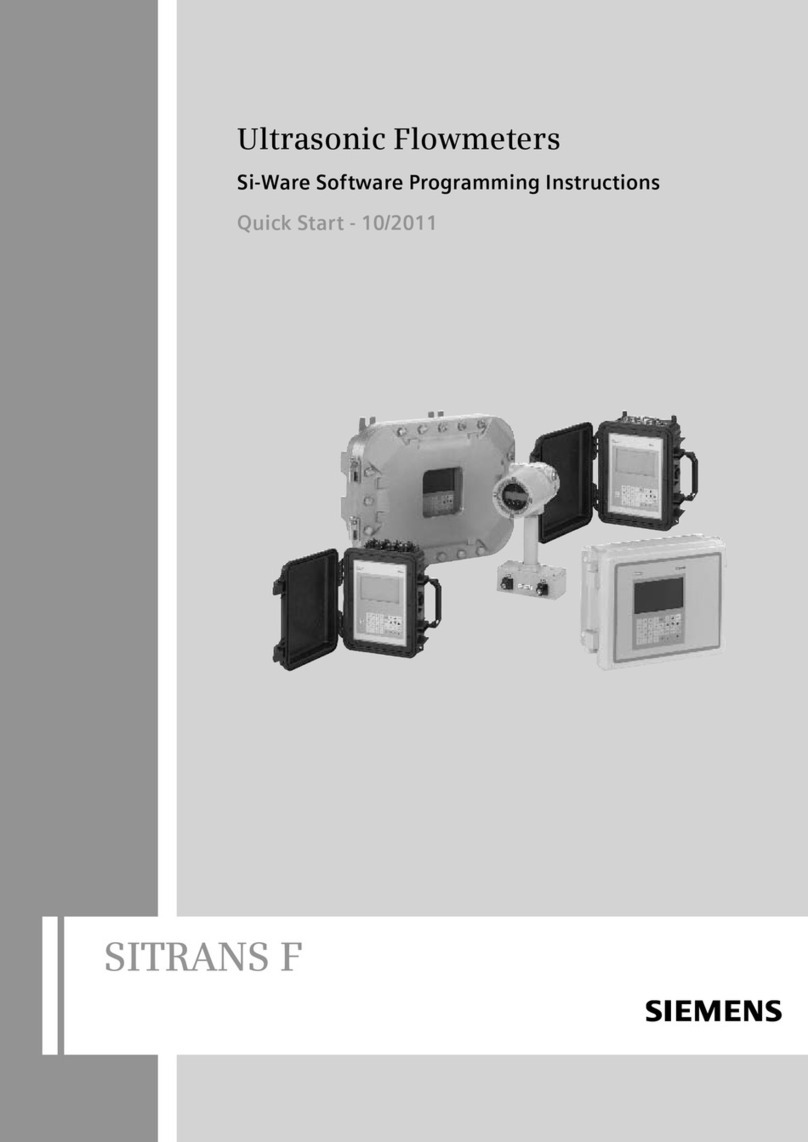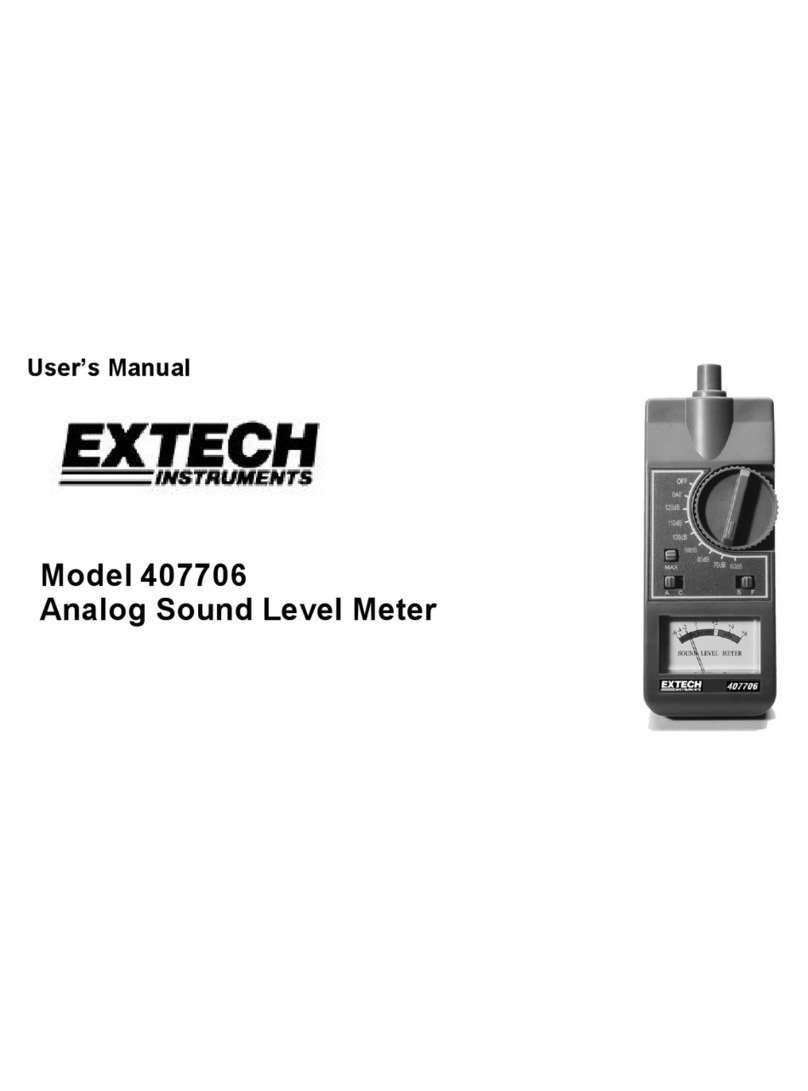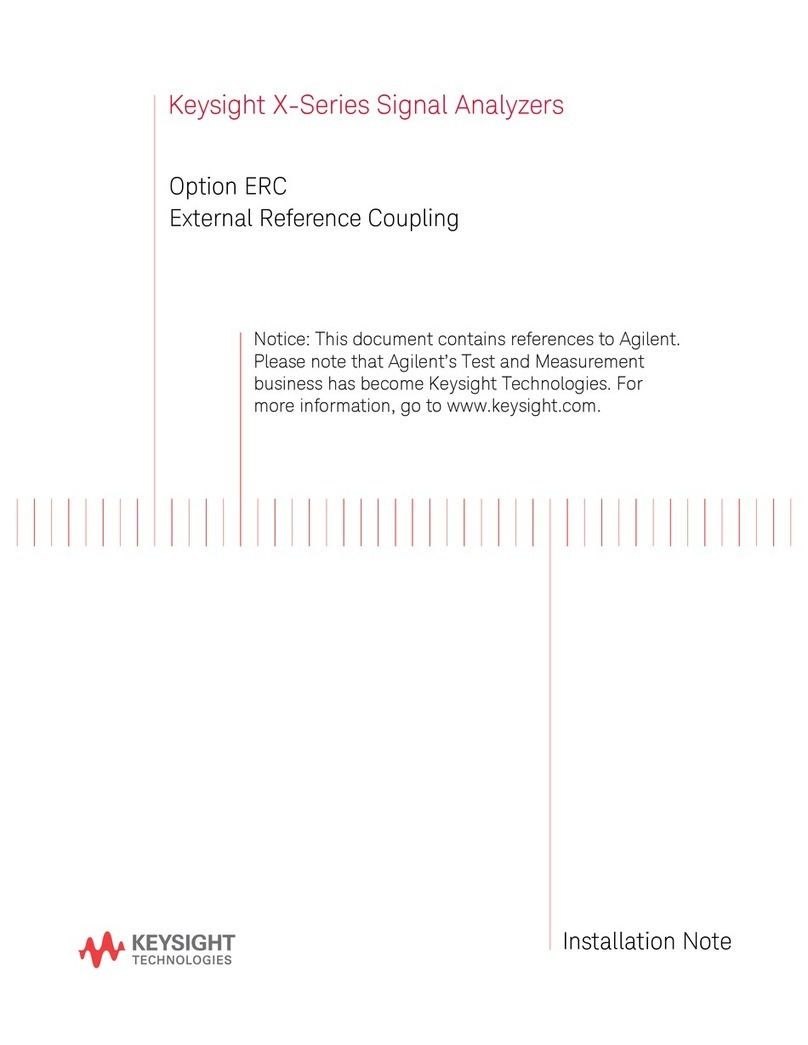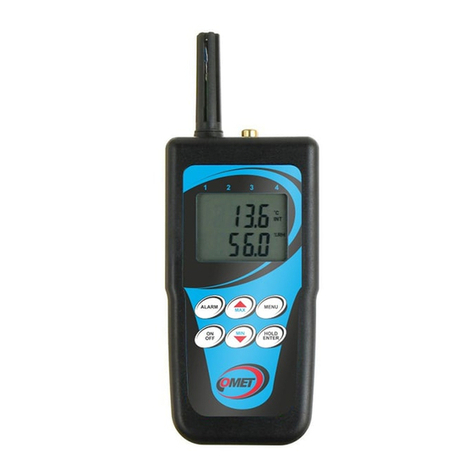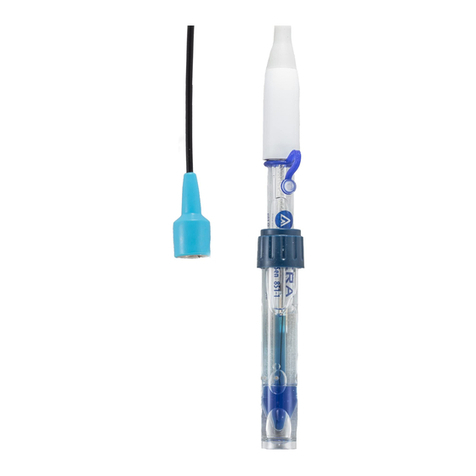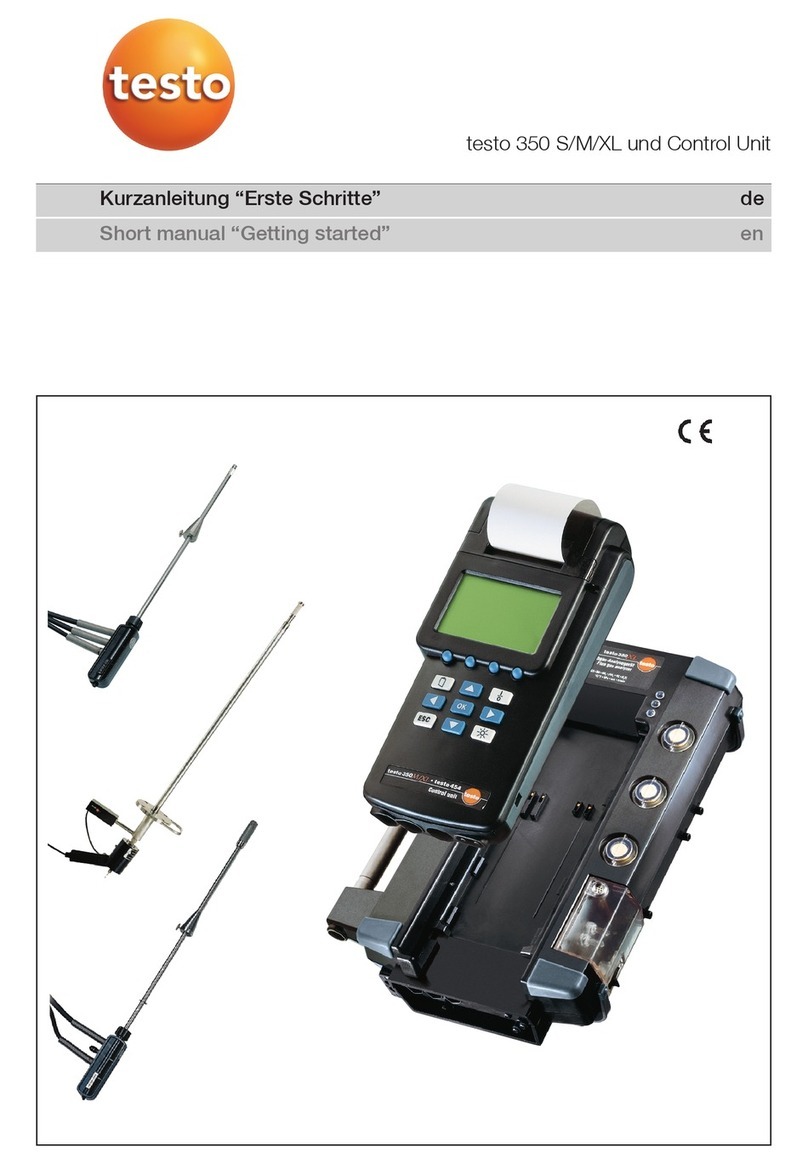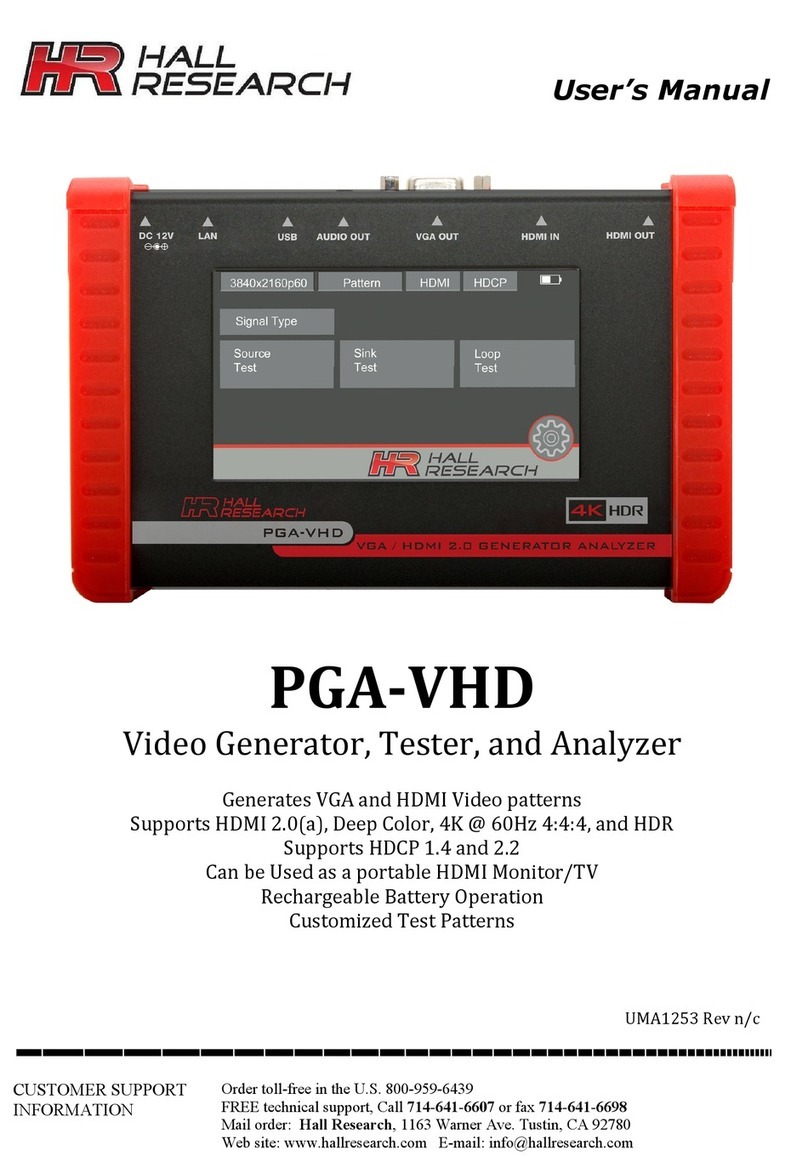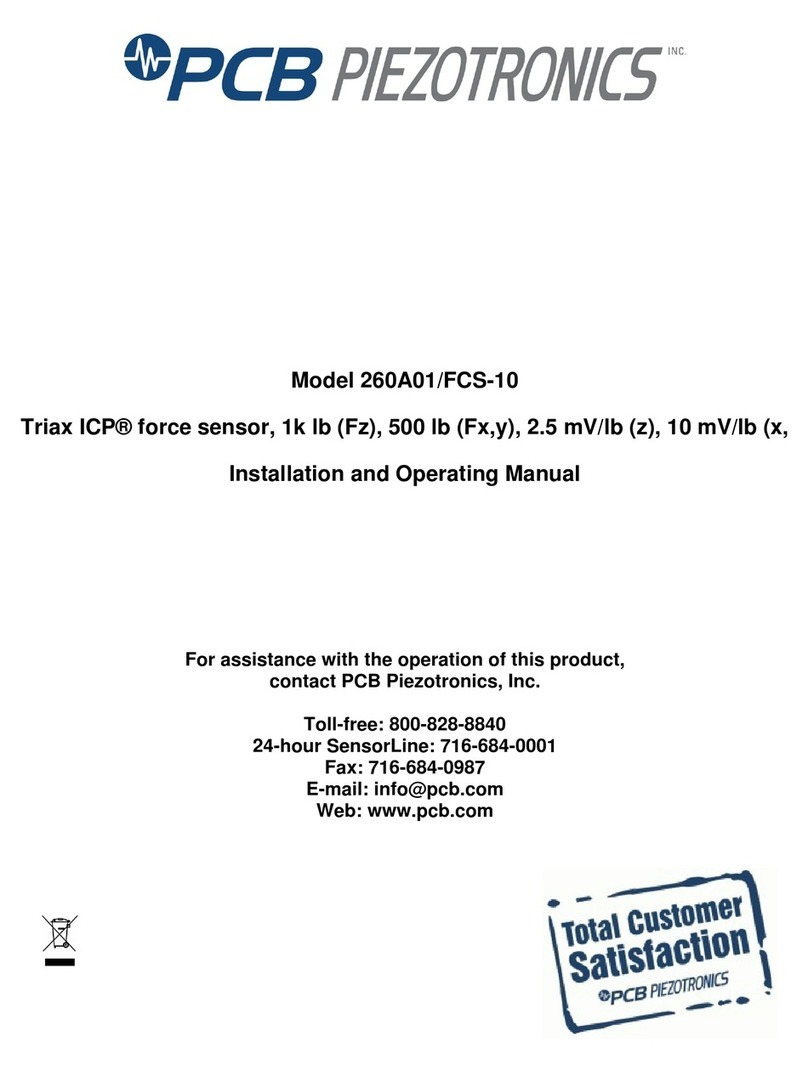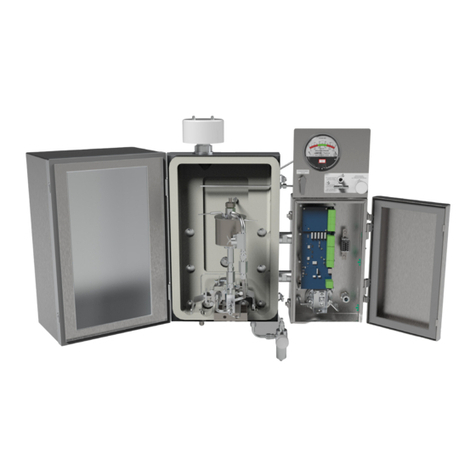Stuart SMP50 User manual

Version 1.3
Melting Point Apparatus
SMP50
Instructions for use

Contents
1. Introduction 4
2. Safety advice before use 4
3. General description 4
4. Preparation for use 5
4.1 Electrical Installation 5
4.2 Installation 6
4.3 Warning 6
5. Instrument and software controls 7
5.1 Instrument 7
5.2 Connecting the accessory printer 7
6. Melting point determination 8
6.1 Terminology 8
6.2 Temperature Settings 8
6.3 Sample Preparation 9
7. Operation 9
7.1 Power up 9
7.2 Main menu screen 10
7.3 Navigation bar 11
8. Settings 11
8.1 Changing the settings 12
9. Creating a user account 13
10. Setting up a new measurement 15
10.1 More options 16
10.2 Add measurement protection 17
11. Running a melting point determination 18
11.1 Sample preparation 18
11.2 Tips on running a melting point determination 18
11.3 Starting a measurement 19
11.4 Viewing a measurement in progress 20
11.5 Aborting a measurement 23

12. Performing a Rapid Melt 23
13. Viewing Melt reports and videos 24
13.1 Manual event tagging 25
13.2 Opening previously saved Melt reports 27
13.3. Deleting or copying a melt report 28
14. Managing measurement files 29
14.1 File display 30
14.2 Searching measurement files 32
14.3 Favourites 34
14.4 Copying and deleting measurement files 35
14.5 Editing measurements 38
15. Managing results files 39
15.1 File display 39
15.2 Searching results files 41
15.3 Favourites 42
15.4 Copying and deleting results files 43
15.5 Viewing results files on a computer 46
15.6 Viewing encrypted results files 46
16. Printing results 47
17. Instrument Calibration 49
17.1 Calibration procedure 49
17.2 Calibration correction factor 54
18. Performing a software update 55
19. Maintenance and servicing 56
19.1 Fuse Replacement 56
19.2 Repairs and Support 56
19.3 Cleaning the Sample Block 57
20. Warranty 58
21. Specification 58
22. Accessories 58
23. Declaration of Conformity 59

4
1. Introduction
Thank you for purchasing this piece of Stuart equipment. To get the best performance from the
SMP50 please read these instructions carefully before use. Before discarding the packaging check that
all parts are present and correct.
For your own safety and that of others please read and understand the safety advice given
below before using the equipment.
2. Safety advice before use
If the equipment is not used in the manner described in this manual and with accessories other than
those recommended by Stuart, the protection provided might be impaired.
Please consult the user manual in all cases where this symbol is identified on the product in
order to find out the nature of any potential hazards and any actions that must be taken to
avoid them.
This equipment is designed to operate under the following conditions:
❖ For indoor use only
❖ Use in a well ventilated area
❖ Ambient temperature range +5°C to +40°C
❖ Altitude to 2000m
❖ Relative humidity not exceeding 80%
❖ Mains supply fluctuation not exceeding 10%
❖ Over-voltage category II IEC 60364-4-443
❖ Pollution degree 2
General safety advice:
❖ Never move or carry the unit when in use or connected to the mains electricity supply.
❖ The unit should be carried using both hands with fingers under each side of the frame.
❖ The ventilation slots at the back of the sample block should not be sealed or obstructed.
Leave at least 100mm clearance.
3. General description
The SMP50 is designed to automatically measure and record the melting temperatures of crystalline
samples held within capillary tubes. Up to three tubes can be accommodated in an illuminated
chamber within an aluminium block. The tubes are monitored by a digital camera; the image of which
can be viewed on the instrument display during the melting process. The device is designed to be
independently operated using the colour touch screen allowing all operational and data management
functions to be performed without the need to attach an external computer or keyboard.
The temperature range of the device is ambient to 400°C and the heating rate is variable between
0.1°C and 20°C/minute. All of the instrument functions and menus are accessed using the colour
touch screen interface which allows fast and intuitive navigation throughout a melting point

5
determination. The instrument has sufficient internal storage capacity for an almost unlimited number
of preset method programs and typically between 250 and 350 result files1. When required, result
files can be transferred from the instrument to a USB flash drive for external storage and archiving.
When a melting point measurement is started the SMP50 heats up to the pre-programmed plateau
temperature at the maximum rate before stabilising at the plateau temperature for two minutes. The
SMP50 will then start to heat at the pre-programmed rate until the melt is complete or until the
device reaches a pre-determined end temperature. Once a melt determination has been completed,
cooling is automatically engaged until the instrument reaches 50°C.
The user is able to review the result file and video, reprocessing the automatically determined results if
required. The results can also be printed off on the accessory printer.
4. Preparation for use
4.1 Electrical installation
THIS INSTRUMENT MUST BE EARTHED
Before connecting the instrument, please read and understand these instructions and ensure that the
electrical supply corresponds to that shown on the rating plate. This unit is designed for use with a
supply rated at 100-230V AC, 50-60Hz. The power consumption of the unit is 150W. The unit is
fitted with an IEC socket at the rear of the instrument for connection of the mains lead.
Caution: Fuses are fitted in both live and neutral lines.
The unit is supplied with two mains leads fitted with IEC plugs for connection to the instrument. One
lead has a UK 3 pin plug and the other has a 2 pin “Shuko” plug for connection to the mains supply.
Choose the lead appropriate for your electrical installation and discard the other. Should neither lead
be suitable take the lead with the UK plug and replace the plug with a suitable alternative. This
involves cutting off the moulded plug, preparing the cable and connecting to the rewireable plug in
accordance with its instructions.
IT IS IMPORTANT THAT THIS OPERATION SHOULD ONLY BE UNDERTAKEN BY A QUALIFIED
ELECTRICIAN.
Refer to the equipment’s rating plate to ensure that the plug and fusing are suitable for the voltage
and wattage stated. The wires in the mains cable are coloured as follows:
LIVE BROWN
NEUTRAL BLUE
EARTH GREEN/YELLOW
The appropriate mains lead should be connected to the instrument BEFORE connection to the mains
supply. Should the mains lead require replacement, a cable of 1mm2of harmonised code H05VV-F
connected to an IEC320 plug should be used. The UK mains lead is protected by a 10A fuse mounted
in the plug top.
❖ Inadequately rated replacement mains leads, which do not meet the specification above,
should not be used.
1The number of result files that can be stored on the SMP50 is largely dependent upon the runtime and size.

6
4.2 Installation
Connect the unit to the electricity supply but DO NOT SWITCH ON. Place the unit on a firm, level,
non-slip surface ensuring that there is sufficient free space on all sides without coming into contact
with anything else during use. Switch the unit ON at the mains On/Off switch at the rear of the
instrument. When switched ON, the touch screen display will illuminate and the interface software
will load within 30 seconds.
Do not position the product so that it is difficult to access the ON/OFF switch.
❖ Do not position the product so that it is difficult to disconnect from the mains supply using
the mains plug.
❖ The mains outlet socket used should be located close to the equipment and readily identifiable
and accessible to users.
❖ Allow the instrument to cool before moving.
IF IN DOUBT CONSULT A QUALIFIED ELECTRICIAN
4.3 Warning
High temperatures are dangerous and can cause serious burns to the operator and ignite
combustible materials. Great care has been taken in the design of this product to protect
operators from hazards, but operators should pay attention to the following points:
❖ The sample block will become hot during operation and will remain hot for a period after
operation.
❖ Sample capillary tubes will become hot during operation and will remain hot for a period after
operation.
❖ Wait for the sample block and capillary tubes to cool before entering the sample
compartment and inserting or removing capillary tubes.
❖ Use care and wear protective gloves to protect hands when working within the sample
compartment and when inserting or removing capillary tubes.
❖ Do not use combustible substances near hot objects.
❖ Do not operate the instrument in the vicinity of flammable liquids or gases.

5. Instrument and software controls
5.1 Instrument
SMP50 front view SMP50 rear view
1. Touch Screen The touch screen interface is used to perform all control
functions on the SMP50. Live images of the sample
compartment, real-time data on the instrument’s status and the
sample block temperature can also be viewed on this display.
2. Capillary storage and cutters A compartment is provided for the storage of glass capillaries
used in the melting point determinations and also incorporates
a device to cut capillary tubes sealed at both ends and tweezers
for removal of broken capillaries from the sample compartment.
3. Sample compartment The lid lifts up to provide access to the sample block which is
capable of holding up to three capillary sample tubes.
Capillary tubes must be a minimum of 5.0cm in length to
ensure that they can be retrieved from the sample block.
4. Capillary holder Three slots moulded in the casework to hold prepared capillaries
prior to performing a melting point determination.
5. USB connections A USB flash drive can be inserted into the USB port allowing
result files to be copied or moved from the device. The port can
also be used to connect to the accessory printer.
6. Mains On/Off This is a rocker type switch found on the rear of the unit.
Pressing the “I” switches the unit ON. Pressing the “O”
switches the unit OFF.
7. A/C power input The socket to which the mains supply lead should be fitted.
Also contains the fuse holder.
5.2 Connecting the accessory printer
If you are using the accessory printer, SMP50/PRINTER, connect the printer USB cable to the USB port
(item 5) of the SMP50 BEFORE turning on the power to the SMP50.
7
1
2
34
5
6
7

8
6. Melting point determination
6.1 Terminology
The capillary technique is a standard method for determining the melting point of a substance. In this
method, thin glass capillary tubes containing prepared samples of a substance are introduced into the
heating block of a suitable device. The block is heated at a fixed rate over a temperature range that
brackets the expected melting temperature of the substance until the substance is completely melted
(clear point).
During the heating cycle the substance under test will often undergo a number of observable physical
changes:
1. Fine droplets adhere uniformly to the inside of the capillary tube.
2. A clearance between the sample and the capillary wall becomes visible.
3. The substance collapses and begins to liquefy.
4. A meniscus is visible at the sample surface but solid particles remains visible (meniscus point).
5. The sample is a clear liquid and no solid particles remain visible (clear point).
When determining the melting point of a substance it is necessary to select one stage in the melting
process which will be used to define the melting point. The meniscus point or clear point is commonly
used to define the melting point of a substance.
The SMP50 automatically reports the clear point, the point at which the sample is a clear
liquid and no solid particles remain, as the melting point of a substance.
Other changes in the physical appearance of the substance are sometimes observed, such as
sublimation (transition from the solid to gas phase with no intermediate liquid stage) or decomposition
(the separation of a substance into its elements or smaller compounds). These changes (if observed)
should be recorded manually.
Where a single melting point is difficult to define for a substance it is often useful to report a melting
range. The melting range of a substance is defined as the interval between the start of a melt and the
clear point.
6.2 Temperature Settings
The temperature settings used to determine a melting point are critical to the accuracy of the
determination.
Start or Plateau Temperature: The start temperature is usually set between 5 and 10˚C below
the expected melting point of the substance.
End Temperature: The end temperature is set at a temperature where all physical
changes in the substance are expected to be complete.
Ramp Rate: The ramp rate is the rate at which the sample block is heated
during the melting point determination. For accurate
determinations a rate of between 0.5˚C/min and 2.0˚C/min is
recommended.
Ramp rate is the most important instrument parameter with regards to the accuracy of a
melting point determination. The use of fast ramp rates is the most common cause of
inaccurate results.

9
6.3 Sample Preparation
For accurate melting point determinations the substance being tested should be in a dry and uniformly
powdered form. Coarse crystalline and non-homogeneous samples should be crushed into a fine
powder using a pestle and mortar before the substance is introduced into a capillary tube.
Each capillary tube in a melting point determination should be prepared in the same way. The open
end of a capillary tube is pressed gently into a small amount of powdered substance until the capillary
contains sufficient material to form a compact layer of 2-4 mm in height. The powder is then forced
to the bottom of the tube by repeatedly tapping the bottom of the capillary against a hard surface.
Excessive amounts of sample in the capillary tubes will result in inaccurate melting point
determinations.
The SMP50 can accommodate up to three sample capillaries. For accurate melting point
determinations it is recommended that three samples of the same material are prepared in the same
way and analysed at the same time. The average of the three capillaries can then be reported as the
melting point.
7. Operation
7.1 Power up
❖ Connect the mains power cable to the instrument and the plug to the mains power supply.
❖ Turn on the power to the instrument using the mains On/Off switch. The instrument will power
up.
Power up screen

7.2 Main menu screen
After a short time the main menu screen is displayed. The Stuart SMP50 is controlled solely through
the touch screen interface of the instrument and follows a basic Android user interface. If the number
of options available in a menu exceeds the number that can be displayed on the screen, use a finger
to scroll across or up and down to view all the options.
Main menu screen showing menu cards
Main menu screen information and cards
Status/Program status: Displays ‘Idle’ unless a measurement is currently running. When a
measurement is running it will display the name of the running program,
the current block temperature and the camera image of the capillary
tubes. The Program status card allows the user access to the program in
progress.
Block temperature: Displays the current temperature of the heating block.
Last calibrated: Displays either Factory calibrated or the date of the last user calibration.
Search: Allows the user to search for measurement and result files.
Measurements card: Options to create a new measurement and run, edit, copy or delete
existing measurements.
Results card: Options to search, view, copy, print and delete results of previous
measurements saved on the instrument.
Rapid ramp card: Run a rapid melting point determination when the specific melting point
of a substance is unknown.
Sign in card: Create a user account with your own settings.
Settings card: Define device settings such as time and date, language, temperature units
etc.
Calibration card: Perform a user-calibration using the melting points of certified reference
standards.
10

11
7.3 Navigation bar
Use the keys on the navigation bar to move between screens:
Back Home Menu
Returns to the Returns to the main menu Shows open
previous screen. screen at any time. applications.
8. Settings
Prior to using the SMP50 it is advised to set up the unit to your own preferences and geographical
location. For accurate record-keeping, set the date and local time before first use. Touching the
Settings card on the main menu screen will open the Settings menu. This consists of device settings,
display formats and results settings.
Settings menu

12
8.1 Changing the settings
The Settings menu is populated with various settings, some of which have default options which can
be changed to suit your individual preferences and geographical location. To change a setting, touch
to select a setting. A pop-up screen will appear. Select the required option from the pop-up screen
then touch the main screen behind or back key to exit.
Device settings
Language: Select either ‘English’ or ‘French’.
Device storage: Displays the total amount of internal memory used and the amount of
memory remaining.
Camera gain: Select either ‘Low’ (default) or ‘High’.
The ‘High’ setting will increase the brightness of the image compared to the
‘Low’ setting. The ‘Low’ setting should be suitable for most melting point
determinations.
Error reporting: Displays details of any errors in QR code format which can be sent to Bibby
Scientific Ltd. for diagnostic purposes.
Notifications: Can be set such that the unit sends a notification for the following:
❖ Measurement completed.
❖ Calibration reminder – can be set to Never (default), Weekly,
Monthly, Bi-annually or Annually.
Date & time: Can be set for regional time zones. Set the date and local time before first
use.
Check USB for Allows you to perform software updates from a USB flash drive. Updates
an update: can be downloaded from www.stuart-equipment.com or contact
software update.
About: Displays information about the currently installed version of software.
Display formats
Temperature units: Select either ‘°Celsius’ or ‘°Fahrenheit’.
Time format: Select either ‘12 Hour’ or ‘24 Hour’.
Results
Save the melt video Select ‘ON’ to save the melting video for future reference. Use the slider
with the report: button to turn on or off.
Encrypt all results Select ‘ON’ to encrypt the results files to prevent post-run editing. Use the
files: slider button to turn on or off.
Note: The SMP50 can serve as part of a US FDA 21 CFR part 11 compliant system relating to its use
to generated results in an electronic format. Results generated on the instrument can be copied to a
USB flash drive in an encrypted format which is protected against tamper or change. The encrypted

13
file can then be stored in a 21 CFR part 11 compliant system. In order to access the results we provide
a reader application which allows a copy of the results to be exported from the encrypted file whilst
keeping the original results intact and unchanged.
Any system seeking to be compliant with US FDA 21 CFR part 11 must still ensure all other provisions
of the regulation are met such as security, auditing, validation and the maintenance of records in an
electronic format, along with their submission to the US FDA.
9. Creating a user account
The SMP50 gives you the option to create your own password-protected user account. When signed
into your account you will be able to set up your own user settings profile.
❖ To create a new account, touch the ‘Sign In’ card.
Sign in card
❖ Touch ‘CREATE ACCOUNT’. This will allow you to create a new user account.
❖ Enter a username followed by ‘Next’ on the keypad (not shown).
Enter a username for the account
❖ Enter and confirm a password then touch ‘Create’ on the keypad.

14
Enter and confirm a password for the account
You will now be signed in as ‘USERNAME’ and this will be shown at the top of the main menu screen.
Once you are signed in to your user account you can edit the settings to your own preferences. These
settings will be saved to your user account.
❖ To exit a user account, touch the ‘Sign Out’ card to return to default settings.
The next time you wish to sign in to your user account, simply touch the ‘Sign In’ card and enter your
username and password.

15
10. Setting up a new measurement
To run a melting point determination you will need to create a measurement profile. This will include
the measurement name, start temperature and ramp rate.
❖ Touch the ‘Measurements’ card on the main menu screen to open the Measurements folder.
❖ Create a new measurement by touching the ‘+’ icon on the action bar at the top of the screen.
Measurements folder with ‘+’ icon highlighted
❖ Touch the card to activate the keypad. Using the keypad (not shown), type in a name for the
measurement followed by ‘Next’.
Naming and specifying the measurement

16
❖ Specify a start temperature. This is typically 5-10°C below the expected melting temperature of the
substance. Touch ‘Next’ on the keypad.
❖ Specify a ramp rate. The minimum is 0.1°C/min, the maximum is 20°C/min. Touch ‘Next’ on the
keypad.
10.1 More options
By default, the end of the melting point determination will be detected automatically. The instrument
will stop heating shortly after this has been detected.
Alternatively you can turn this function off and enter an end temperature using the ‘More options’
card.
More options
❖ Touch the selector to turn ‘OFF’ automatic detection of the melt end.
❖ Using the keypad, type in an end temperature. Touch ‘Next’ on the keypad.
If an end temperature is set, during the melting point determination the instrument will continue
heating until the specified end temperature is reached.
In the ‘More options’ card you may also add a reference for this measurement. This can be used to
identify, for example, a specific batch number or experiment.
❖ Touch ‘Reference’ and using the keypad, type a reference name.
❖ Touch ‘Next’ to continue to the next screen.

10.2 Add measurement protection
On this card you have options to password protect the measurement for security against changes from
other users. A password can be set so that it is required to enter it when you wish to perform one or
more of the following operations:
❖ Change (edit) the measurement.
❖ Stop the measurement while it is running.
❖ Delete the measurement.
❖ To add measurement protection, touch the card and type in a password.
❖ Touch to select the required option(s) you wish to protect against followed by ‘SAVE’. Select ‘SAVE
AND RUN’ if you wish to run the measurement immediately.
Options available for measurement protection
With measurement protection enabled the measurement file card will display a padlock icon. The
password is required for any changes to be made.
Measurement protection enabled
17

18
11. Running a melting point determination
11.1 Sample preparation
This section provides guidelines for sample preparation before performing a melting point
determination.
1. For accurate melting point determinations, ensure the sample is dry. Dry the sample overnight in a
vacuum desiccator with desiccant under reduced pressure if necessary.
2. Place a small quantity of the dry sample on a watch glass or in a mortar and grind to a fine
powder with a glass rod or pestle. Coarse, crystalline samples will give uneven heat transfer
through the sample.
3. The glass capillary tube should be sealed at one end; if the capillary tube is open at both ends, seal
one of the ends using the flame of a Bunsen burner. If the capillary is sealed at both ends, use the
cutter provided in the capillary storage compartment to cut the capillary in half. Roll the capillary
across the cutter to score the glass then press down firmly until it snaps cleanly across the score
line.
Note: Capillary tubes must be a minimum of 5.0cm in length to ensure that they can be
retrieved from the sample block.
4. Gather the powdered sample into a small pile. Press the open end of the capillary into the sample
to a depth of around 2mm.
5. Invert the capillary and tap the tube to pack the sample down in the sealed end. Repeat as
necessary; the final height of the sample should be between 2-4mm.
6. If preparing multiple samples, prepare them in the same way with the same height of sample in
each tube. For accurate melting point determinations it is recommended that three samples of the
same material are prepared in the same way and analysed at the same time. The average of the
results from the three capillaries can then be reported as the melting point of the sample.
11.2 Tips on running a melting point determination
❖ Ensure there is no sample on the outside of the tube before inserting it into the melting point
apparatus.
❖ A sample should be used only once for melting point determination as some substances
chemically decompose on heating.
❖ Do not heat the sample too quickly; generally 1-2ºC/minute is recommended.
❖ If the melting temperature of the substance is unknown, first perform a rapid melt with a
ramp rate of up to 20ºC/minute. Once the approximate melting point is known, a more
appropriate plateau can be set and a slower ramp rate used. See section 12 for how to
perform a rapid ramp measurement.

19
11.3 Starting a measurement
❖ Place the prepared capillaries in the sample compartment and close the lid.
❖ From the main menu screen select the ‘Measurements’ card.
❖ Swipe up or down the screen to find the required measurement program and touch to open. If
the measurement has not yet been defined, please follow section 10, Setting up a new
Measurement.
Note: If there are many measurements saved on the instrument, the search function may help to find
the required file more quickly. Please see section 14.2 for how to search for a file.
Measurement file card open
The measurement file card shows a summary of the measurement parameters.
❖ Touch ‘RUN’ to start the measurement.

20
11.4 Viewing a measurement in progress
Once the command to run has been sent, the run screen will show the camera display and status of
the measurement in progress.
Run screen status ‘Heating’
1. File name of the measurement. The back arrow returns to the previous screen.
2. Camera display screen. Shows a live display of the capillary tubes inside the heating chamber.
3. Current temperature of the heating block.
4. Heating status of the program. This will progress through three stages:
1. Heating: the heating block is heating rapidly to the start temperature.
2. Stabilising: the heating block is stabilising at the start temperature.
This continues for two minutes.
3. Ramping: the heating block is heating at the programmed ramp rate.
5. Measurement profile including start temperature, end temperature (or auto) and ramp rate.
6. Sample status for each tube e.g. solid, melting, liquid or finished. (For information only).
The instrument will first heat up to the start temperature programmed in the measurement. The
current status will indicate ‘Heating’.
Once the start temperature has been reached, the heating block will stabilise at this temperature for
two minutes. The current status will indicate ‘Stabilising’.
Table of contents
Popular Measuring Instrument manuals by other brands

ARENDO
ARENDO 305660 user manual
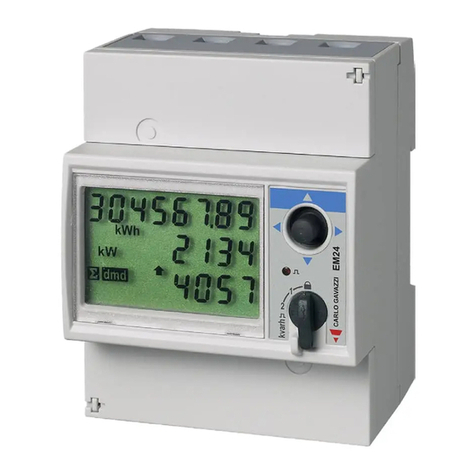
CARLO GAVAZZI
CARLO GAVAZZI EM24 IS-R2-O2 Series user manual

Lignomat
Lignomat Ligno-Scanner SD User instructions
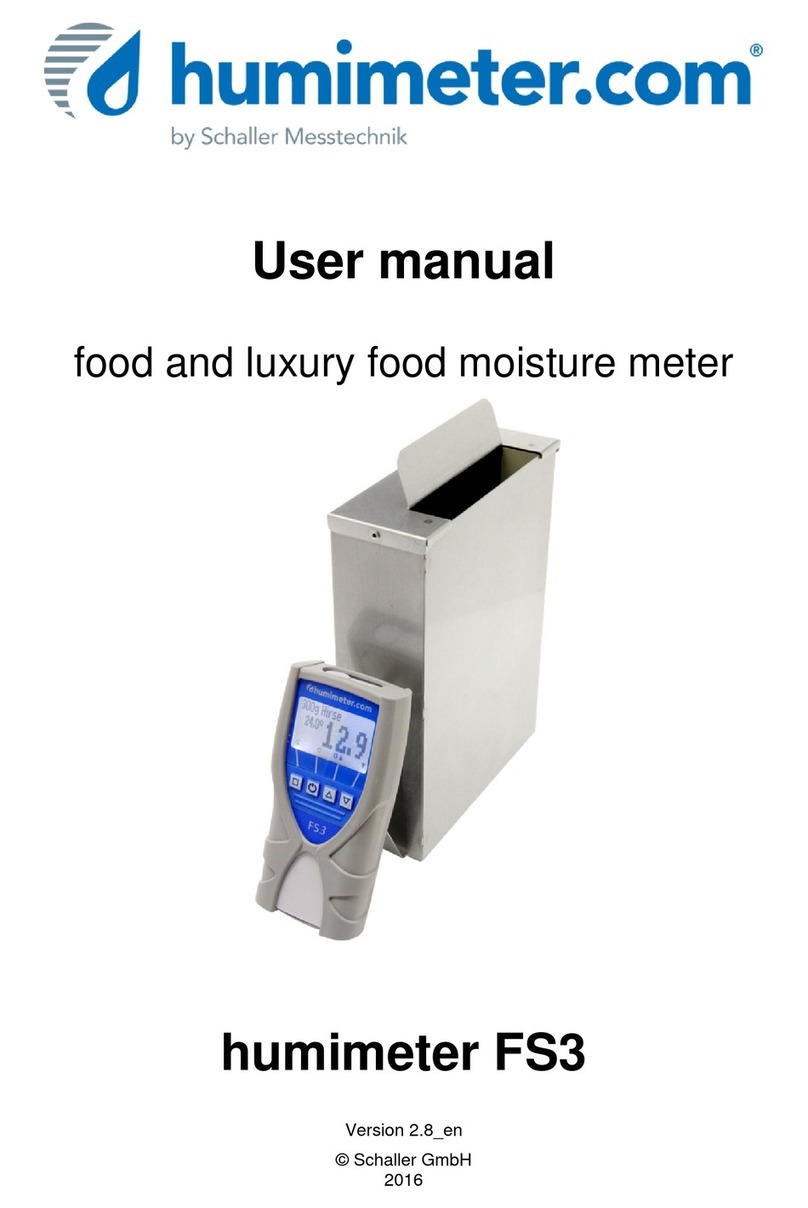
humimeter.com
humimeter.com humimeter FS3 user manual
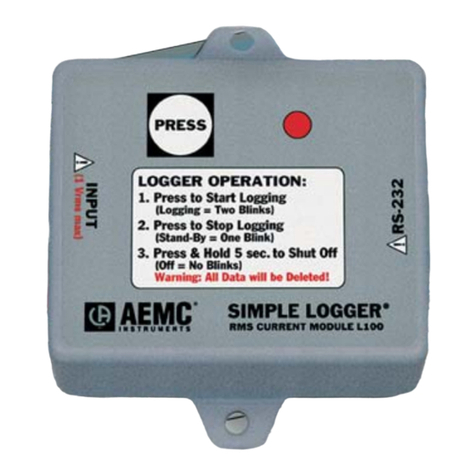
AEMC instruments
AEMC instruments SIMPLE LOGGER L100 quick start guide
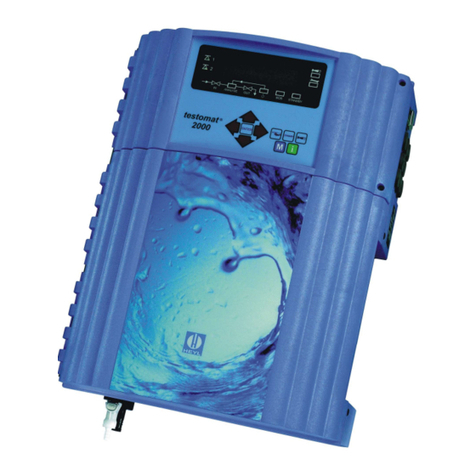
Heyl
Heyl Testomat 2000 THCL operating instructions
